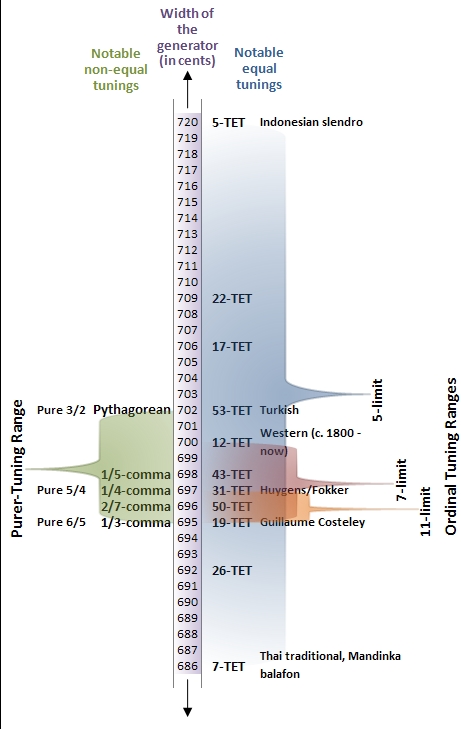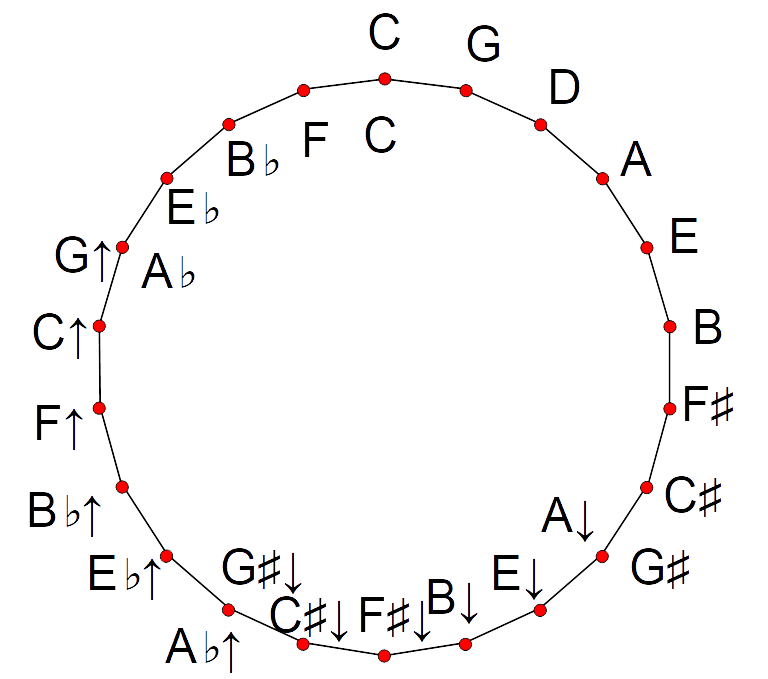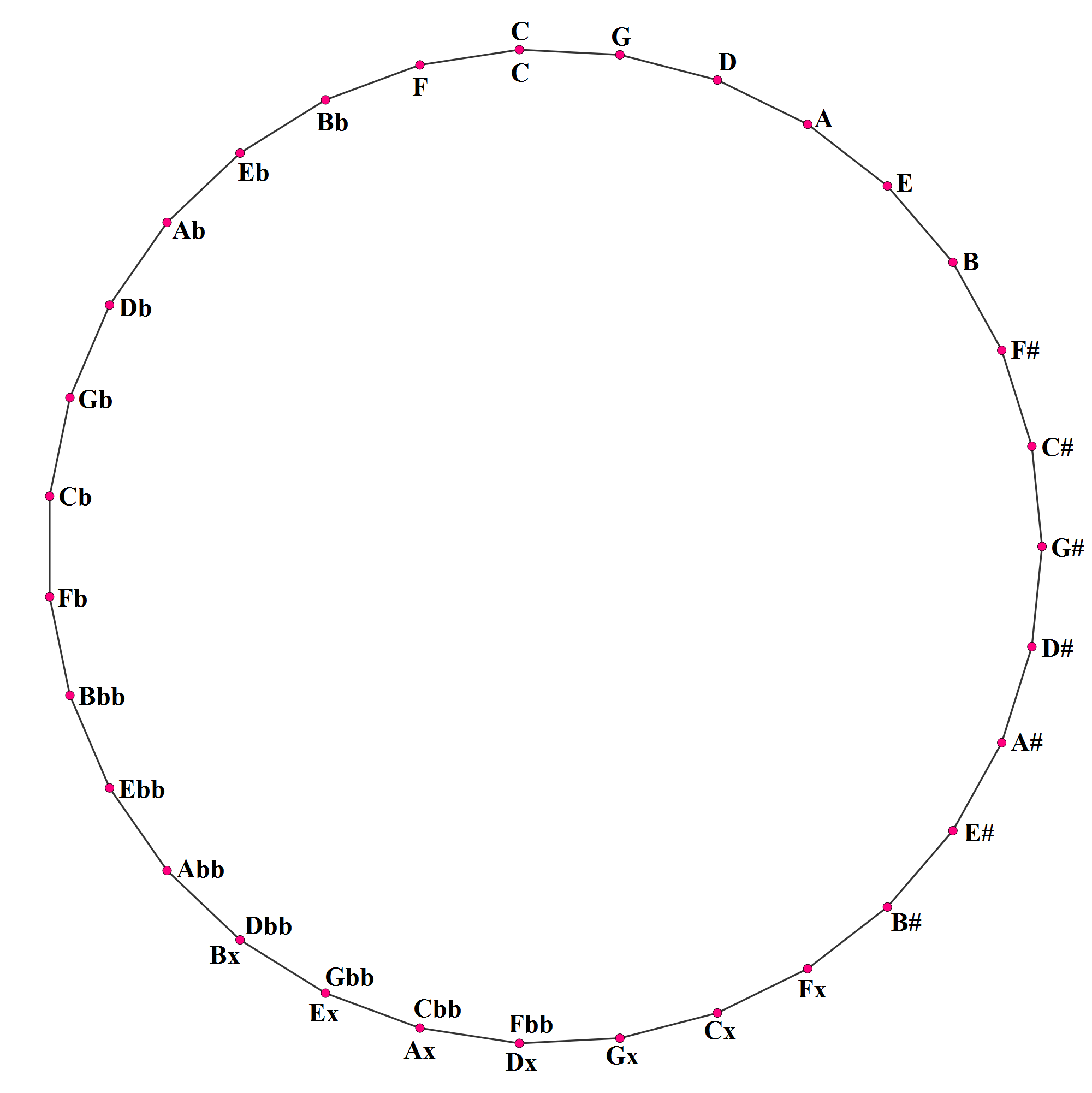|
Septimal Semicomma
In music, the septimal semicomma, a seven- limit semicomma, is the ratio 126/125 and is equal to approximately 13.79 cents (). It is also called the ''small septimal comma''Haluska, Jan (2003). ''The Mathematical Theory of Tone Systems'', p.xxvi. . and the ''starling comma'' after its use in starling temperament. Factored into primes it is: 2*3^2*5^*7 Or as simple just intervals: (6/5)^3*(7/6)*(2/1)^ Thus it is the difference between three minor thirds of 6/5 plus a septimal minor third of 7/6 and an octave (2/1). This comma is important to certain tuning systems, such as septimal meantone temperament. A diminished seventh chord consisting of three minor thirds and a subminor third making up an octave is possible in such systems. This characteristic feature of these tuning systems is known as the ''septimal semicomma diminished seventh chord''. In equal temperament It is tempered out in 19 equal temperament and 31 equal temperament, but not in 22 equal temperament, 34 equa ... [...More Info...] [...Related Items...] OR: [Wikipedia] [Google] [Baidu] |
Music
Music is generally defined as the art of arranging sound to create some combination of form, harmony, melody, rhythm or otherwise expressive content. Exact definitions of music vary considerably around the world, though it is an aspect of all human societies, a cultural universal. While scholars agree that music is defined by a few specific elements, there is no consensus on their precise definitions. The creation of music is commonly divided into musical composition, musical improvisation, and musical performance, though the topic itself extends into academic disciplines, criticism, philosophy, and psychology. Music may be performed or improvised using a vast range of instruments, including the human voice. In some musical contexts, a performance or composition may be to some extent improvised. For instance, in Hindustani classical music, the performer plays spontaneously while following a partially defined structure and using characteristic motifs. In modal jazz ... [...More Info...] [...Related Items...] OR: [Wikipedia] [Google] [Baidu] |
19 Equal Temperament
In music, 19 Tone Equal Temperament, called 19 TET, 19 EDO ("Equal Division of the Octave"), or 19 ET, is the tempered scale derived by dividing the octave into 19 equal steps (equal frequency ratios). Each step represents a frequency ratio of , or 63.16 cents (). The fact that traditional western music maps unambiguously onto this scale (unless it presupposes 12-EDO enharmonic equivalences) makes it easier to perform such music in this tuning than in many other tunings. 19 EDO is the tuning of the syntonic temperament in which the tempered perfect fifth is equal to 694.737 cents, as shown in Figure 1 (look for the label "19 TET"). On an isomorphic keyboard, the fingering of music composed in 19 EDO is precisely the same as it is in any other syntonic tuning (such as 12 EDO), so long as the notes are "spelled properly" – that is, with no assumption that the sharp below matches the flat immediately above it ( enharmo ... [...More Info...] [...Related Items...] OR: [Wikipedia] [Google] [Baidu] |
7-limit Tuning And Intervals
7-limit or septimal tunings and intervals are musical instrument tunings that have a limit of seven: the largest prime factor contained in the interval ratios between pitches is seven. Thus, for example, 50:49 is a 7-limit interval, but 14:11 is not. For example, the greater just minor seventh, 9:5 () is a 5-limit ratio, the harmonic seventh has the ratio 7:4 and is thus a septimal interval. Similarly, the septimal chromatic semitone, 21:20, is a septimal interval as 21÷7=3. The harmonic seventh is used in the barbershop seventh chord and music. () Compositions with septimal tunings include La Monte Young's ''The Well-Tuned Piano'', Ben Johnston's String Quartet No. 4, Lou Harrison's ''Incidental Music for Corneille's Cinna'', and Michael Harrison's ''Revelation: Music in Pure Intonation''. The Great Highland bagpipe is tuned to a ten-note seven-limit scale: 1:1, 9:8, 5:4, 4:3, 27:20, 3:2, 5:3, 7:4, 16:9, 9:5. In the 2nd century Ptolemy described the sept ... [...More Info...] [...Related Items...] OR: [Wikipedia] [Google] [Baidu] |
53 Equal Temperament
In music, 53 equal temperament, called 53 TET, 53 EDO, or 53 ET, is the tempered scale derived by dividing the octave into 53 equal steps (equal frequency ratios). Each step represents a frequency ratio of 2, or 22.6415 cents (), an interval sometimes called the Holdrian comma. 53-TET is a tuning of equal temperament in which the tempered perfect fifth is 701.89 cents wide, as shown in Figure 1. The 53-TET tuning equates to the unison, or ''tempers out'', the intervals , known as the schisma, and , known as the kleisma. These are both 5 limit intervals, involving only the primes 2, 3 and 5 in their factorization, and the fact that 53 ET tempers out both characterizes it completely as a 5 limit temperament: it is the only regular temperament tempering out both of these intervals, or commas, a fact which seems to have first been recognized by Japanese music theorist Shohé Tanaka. Because it tempers these out, 53-TET can b ... [...More Info...] [...Related Items...] OR: [Wikipedia] [Google] [Baidu] |
41 Equal Temperament
In music, 41 equal temperament, abbreviated 41-TET, 41- EDO, or 41-ET, is the tempered scale derived by dividing the octave into 41 equally sized steps (equal frequency ratios). Each step represents a frequency ratio of 21/41, or 29.27 cents (), an interval close in size to the septimal comma. 41-ET can be seen as a tuning of the schismatic, magic and miracle temperaments. It is the second smallest equal temperament, after 29-ET, whose perfect fifth is closer to just intonation than that of 12-ET. In other words, 2^ \approx 1.50042 is a better approximation to the ratio 3/2 = 1.5 than either 2^ \approx 1.50129 or 2^ \approx 1.49831. History and use Although 41-ET has not seen as wide use as other temperaments such as 19-ET or 31-ET , pianist and engineer Paul von Janko built a piano using this tuning, which is on display at the Gemeentemuseum in The Hague. 41-ET can also be seen as an octave-based approximation of the Bohlen–Pierce scale. 41-ET guitars have been built, ... [...More Info...] [...Related Items...] OR: [Wikipedia] [Google] [Baidu] |
34 Equal Temperament
In musical theory, 34 equal temperament, also referred to as 34-TET, 34- EDO or 34-ET, is the tempered tuning derived by dividing the octave into 34 equal-sized steps (equal frequency ratios). Each step represents a frequency ratio of , or 35.29 cents . History and use Unlike divisions of the octave into 19, 31 or 53 steps, which can be considered as being derived from ancient Greek intervals (the greater and lesser diesis and the syntonic comma), division into 34 steps did not arise 'naturally' out of older music theory, although Cyriakus Schneegass proposed a meantone system with 34 divisions based in effect on half a chromatic semitone (the difference between a major third and a minor third, 25:24 or 70.67 cents). Wider interest in the tuning was not seen until modern times, when the computer made possible a systematic search of all possible equal temperaments. While Barbour discusses it,''Tuning and Temperament'', Michigan State College Press, 1951 the first recognition of ... [...More Info...] [...Related Items...] OR: [Wikipedia] [Google] [Baidu] |
22 Equal Temperament
In music, 22 equal temperament, called 22-TET, 22- EDO, or 22-ET, is the tempered scale derived by dividing the octave into 22 equal steps (equal frequency ratios). Each step represents a frequency ratio of , or 54.55 cents (). When composing with 22-ET, one needs to take into account a variety of considerations. Considering the 5-limit, there is a difference between 3 fifths and the sum of 1 fourth + 1 major third. It means that, starting from C, there are two A's - one 16 steps and one 17 steps away. There is also a difference between a major tone and a minor tone. In C major, the second note (D) will be 4 steps away. However, in A minor, where A is 6 steps below C, the fourth note (D) will be 9 steps above A, so 3 steps above C. So when switching from C major to A minor, one need to slightly change the note D. These discrepancies arise because, unlike 12-ET, 22-ET does not temper out the syntonic comma of 81/80, and in fact exaggerates its size by mapping it to one step. Ext ... [...More Info...] [...Related Items...] OR: [Wikipedia] [Google] [Baidu] |
31 Equal Temperament
In music, 31 equal temperament, 31-ET, which can also be abbreviated 31-TET (31 tone ET) or 31- EDO (equal division of the octave), also known as tricesimoprimal, is the tempered scale derived by dividing the octave into 31 equal-sized steps (equal frequency ratios). Each step represents a frequency ratio of , or 38.71 cents (). 31-ET is a very good approximation of quarter-comma meantone temperament. More generally, it is a regular diatonic tuning in which the tempered perfect fifth is equal to 696.77 cents, as shown in Figure 1. On an isomorphic keyboard, the fingering of music composed in 31-ET is precisely the same as it is in any other syntonic tuning (such as 12-ET), so long as the notes are spelled properly — that is, with no assumption of enharmonicity. History and use Division of the octave into 31 steps arose naturally out of Renaissance music theory; the lesser diesis — the ratio of an octave to three major thirds, 128:125 or 41.06 cents — was approximat ... [...More Info...] [...Related Items...] OR: [Wikipedia] [Google] [Baidu] |
Diminished Seventh Chord
The diminished seventh chord is a four-note chord (a seventh chord) composed of a root note, together with a minor third, a diminished fifth, and a diminished seventh above the root: (1, 3, 5, 7). For example, the diminished seventh chord built on C, commonly written as C7, has pitches C–E–G–B (A): : As such, a diminished seventh chord comprises a diminished triad plus a diminished seventh. Because of this, it can also be viewed as four notes all stacked in intervals of a minor third and can be represented by the integer notation . Since a diminished seventh interval is enharmonically equivalent to a major sixth, the chord is enharmonically equivalent to (1, 3, 5, 6). The diminished seventh chord occurs as a leading-tone seventh chord in the harmonic minor scale. It typically has dominant function and contains two diminished fifths, which often resolve inwards. In most sheet music books, the notation Cdim or C denotes a diminished seventh ... [...More Info...] [...Related Items...] OR: [Wikipedia] [Google] [Baidu] |
7-limit
7-limit or septimal tunings and intervals are musical instrument tunings that have a limit of seven: the largest prime factor contained in the interval ratios between pitches is seven. Thus, for example, 50:49 is a 7-limit interval, but 14:11 is not. For example, the greater just minor seventh, 9:5 () is a 5-limit ratio, the harmonic seventh has the ratio 7:4 and is thus a septimal interval. Similarly, the septimal chromatic semitone, 21:20, is a septimal interval as 21÷7=3. The harmonic seventh is used in the barbershop seventh chord and music. () Compositions with septimal tunings include La Monte Young's ''The Well-Tuned Piano'', Ben Johnston's String Quartet No. 4, Lou Harrison's ''Incidental Music for Corneille's Cinna'', and Michael Harrison's ''Revelation: Music in Pure Intonation''. The Great Highland bagpipe is tuned to a ten-note seven-limit scale: 1:1, 9:8, 5:4, 4:3, 27:20, 3:2, 5:3, 7:4, 16:9, 9:5. In the 2nd century Ptolemy described the septimal ... [...More Info...] [...Related Items...] OR: [Wikipedia] [Google] [Baidu] |
Septimal Meantone Temperament
In music, septimal meantone temperament, also called ''standard septimal meantone'' or simply ''septimal meantone'', refers to the tempering of 7-limit musical intervals by a meantone temperament tuning in the range from fifths flattened by the amount of fifths for 12 equal temperament to those as flat as 19 equal temperament, with 31 equal temperament being a more or less optimal tuning for both the 5- and 7-limits. Meantone temperament represents a frequency ratio of approximately 5 by means of four fifths, so that the major third, for instance C–E, is obtained from two tones in succession. Septimal meantone represents the frequency ratio of 56 (7 × 23) by ten fifths, so that the interval 7:4 is reached by five successive tones. Hence C–A, not C–B, represents a 7:4 interval in septimal meantone. :*A ≈ B *C — G — D — A — E — B — F — C — G — D — A *C — ≈G — ≈D — ≈A — ≈E — ≈B — ≈F — ≈C — ≈G — ≈D — =B The ... [...More Info...] [...Related Items...] OR: [Wikipedia] [Google] [Baidu] |
Septimal Minor Third
In music, the septimal minor third, also called the subminor third (e.g., by Ellis), is the musical interval exactly or approximately equal to a 7/6 ratio of frequencies. In terms of cents, it is 267 cents, a quartertone of size 36/35 flatter than a just minor third of 6/5. In 24-tone equal temperament five quarter tones approximate the septimal minor third at 250 cents (). A septimal minor third is almost exactly two-ninths of an octave, and thus all divisions of the octave into multiples of nine (72 equal temperament being the most notable) have an almost perfect match to this interval. The septimal major sixth, 12/7, is the inverse of this interval. The septimal minor third may be derived in the harmonic series from the seventh harmonic, and as such is in inharmonic ratios with all notes in the regular 12TET scale, with the exception of the fundamental and the octave. It has a darker but generally pleasing character when compared to the 6/5 third. A triad formed by using ... [...More Info...] [...Related Items...] OR: [Wikipedia] [Google] [Baidu] |






